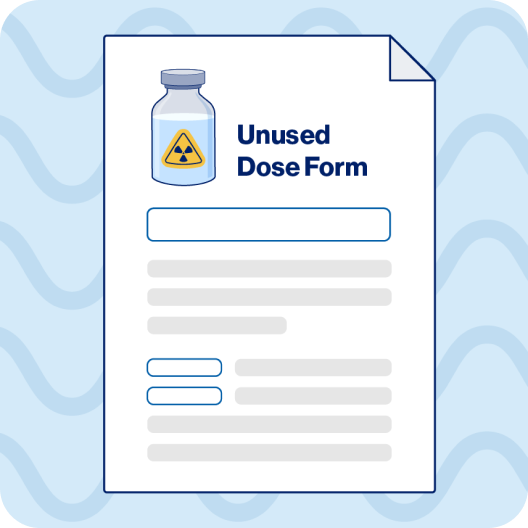
Providing and administering RLT
This section of the Novartis RLT Institute is designed to help health care professionals (HCPs) understand radiation safety procedures for providing and administering radioligand therapies (RLTs) manufactured by Novartis. It is based on guidelines from regulatory agencies, including the Nuclear Regulatory Commission (NRC), the Department of Transportation (DOT), and the United States Pharmacopeia (USP). Topics include safe transport, administration, and postadministration protocols to prepare the patient and room for subsequent use.
Postadministration
Clinic considerations
Safe use of RLT relies on effective waste management, thorough clearance of areas and staff, and precise documentation. These practices minimize the possibility of contamination to protect health and ensure compliance with regulations.1,2

Waste management
Radioactive waste may include items used in the administration procedure (eg, vials, needles, tubing, swabs, gloves, gowns, and absorbent pads) if these items are contaminated and cannot be wiped clean. Survey all items to confirm if they are contaminated and dispose according to institutional guidelines.1,2
See more about waste managementArea clearance
Clear areas where radioactive material was used and survey to ensure there is no contamination before releasing. Ensure all contamination has been removed or decayed to background levels and the area is within normal limits of radiation before turnover.2
Staff clearance
All personnel involved with the handling of RLT should always survey their hands and clothing frequently to monitor for radiation contamination, follow recommended procedures for clearance, and take appropriate measures if contamination is discovered.2


Expert insight
Consult the radiation safety officer for center-specific protocols for staff.2 For example, the staff may wash hands with soap and water, use binding cleaners, and change into an extra pair of scrubs, letting the contaminated scrubs decay following the postadministration clearance procedure.3
Documentation
Several key documents are required to ensure patient safety, regulatory compliance, and treatment efficacy.2,4
Written directive
A written directive is a mandatory document that must be completed and signed before administering therapeutic doses of radioactive materials. It ensures accurate treatment and compliance with radiation protection standards.5
The written directive must include2,5:
- Patient identifiers
- Type of radiopharmaceutical
- Prescribed activity
- Administration route of the radioactive material
The written directive is signed by an authorized user to confirm that the treatment is in accordance with regulatory requirements, ensuring both patient safety and quality assurance in radiation therapies.5
Administered activity
In addition, calculation of administered activity (assayed dose) must be performed. This includes determining the dose assayed before infusion and subtracting the syringe residual dose after infusion.6,7

Unused doses
In cases where a Novartis RLT product was received by the facility but not delivered to the patient, the facility may complete an unused dose form. The unused product will follow waste management protocols and may accordingly decay in storage at the facility.3
For more information, contact Novartis Customer Support at customerserv-us.aaa@novartis.com or +1-844-367-3222.
